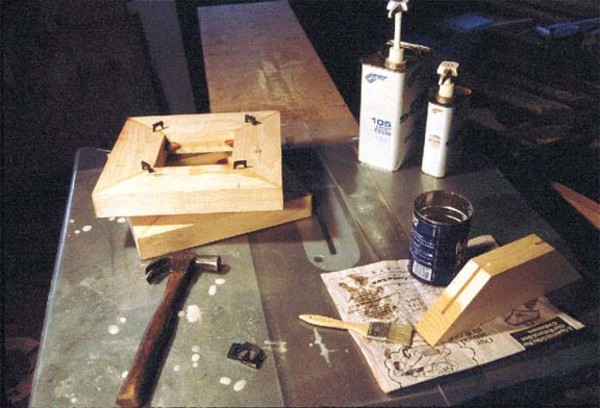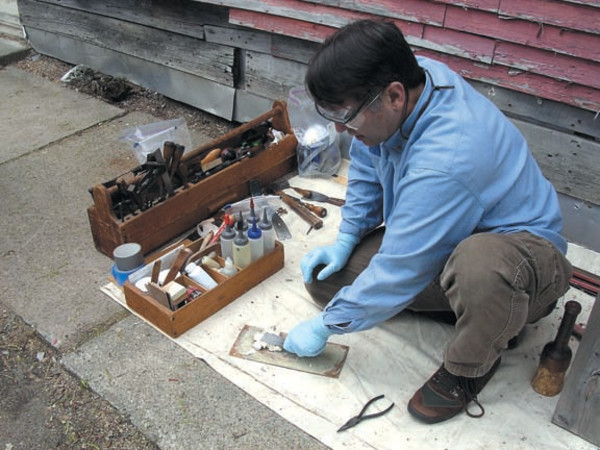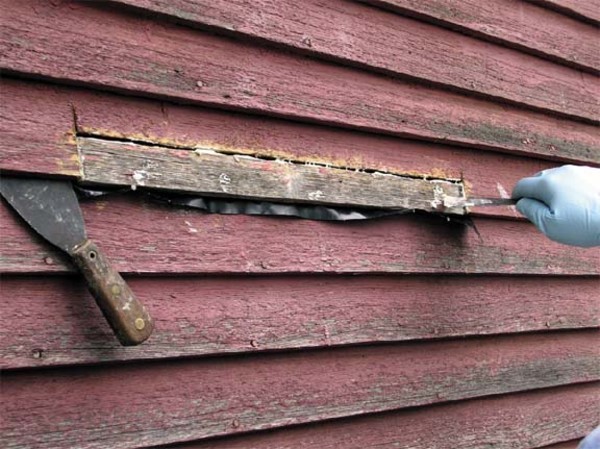The strength, adhesion, and moisture resistance of epoxies makes them excellent wood adhesives for new exterior woodwork, such as these post bases.
Who hasn’t heard of epoxy? Epoxies have been used since the 1940s to manufacture a wide variety of products and, in the last three decades, have become a primary tool for repairing building materials, especially wood and concrete. While some companies tout their epoxy products as close to miracle cures that can mend broken metal or revive deteriorated wood, there are also architectural conservators who believe that epoxies do more harm than good. To make things worse, there are many products on the market that are used similarly to—and often confused with—epoxies. All this can leave old-house owners scratching their heads. Is there a practical, middle ground where epoxies can be used to save exterior woodwork successfully? And just what is this epoxy stuff? A look at the nature and growing applications of this remarkable chemical repair technology can help answer these questions.
Epoxy Basics
Epoxy belongs to a broad family of thermosetting compounds—in simple terms, plastics that cure by heat reaction. Widely used epoxies like adhesives and casting materials are commonly made up of two liquids: an epoxy resin and a curing agent called a hardener. When the resin and hardener are mixed together, a chemical reaction takes place and the resin transforms into a solid mass. During the reaction, single molecules (monomers) of the epoxy resin and the curing agent combine to form chains of molecules (polymers). As the mixture cures, the chains grow longer, the solution gels, and then it hardens.
Epoxy materials are very adaptable. The chemists who design and formulate epoxies can give them a wide range of pre-cure and post-cure characteristics. It all depends on which epoxy monomers, curing agents, solvents, and fillers they add. The pre-cure mix can be thin as water to penetrate porous materials, or thick and viscous to stay put on vertical surfaces. The cured epoxy can be nearly as hard and brittle as glass, or almost as soft and flexible as rubber bands. Even the rate of cure can be adjusted to meet very specific needs. An epoxy that takes hours to gel can penetrate deeply into porous wood, while products that set up in minutes can be good for adhesives and floor coatings where the area must be put back into service as soon as possible. Many epoxy systems also contain additives, such as plasticizers to make them more flexible, organic solvents to make them more spreadable, and fillers, such as sand, to add bulk and reduce costs. Mixing in pigments adds color.
Since epoxies bond exceptionally well to a wide range of materials, they make excellent adhesives. Good bonding also means that epoxies are useful for making composite materials. For example, we can reinforce a repair by layering epoxy and fabric so that the resulting composite bonds to its surroundings, or by mixing the resin with powdery fillers or chopped fibers to make a paste that fills voids.
Epoxy fillers are two-part products composed of resin and hardener that must be thoroughly mixed before use.
What’s the point of all this adaptability? It makes epoxies compatible with the characteristics of traditional building materials—from stone, glass, and concrete to terra cotta and wood. For example, epoxies designed for wood repairs are specifically formulated to match the strength of wood and be flexible enough to move with its cycles of contraction and expansion. In fact, several manufacturers offer kits of epoxies specially formulated for such repairs that include one or more of the following specialized product types:
Epoxy consolidant: Liquid resin formulated to soak into fibrous materials, such as wood. The amount of penetration depends mainly on the dryness of the wood. Other technical considerations, such as capillarity, interfacial tension, molecular size, temperature, consistency, and gel time also play important roles.
Epoxy primer: Liquid formulated to prepare a surface for good adhesion of another material such as an epoxy paste filler.
Epoxy paste filler: Adhesive paste composed of a two-part liquid epoxy that is similar to consolidant. Manufacturers blend in powdery thickeners to give each paste a consistency that ranges from mayonnaise to stiff mashed potatoes. Other fillers give the cured paste the strength and flexibility characteristics of wood. You can even formulate your own paste by starting with epoxy resin, then adding familiar materials like sawdust and a little corn starch. Commercially prepared materials, however, are much more consistent and reliable.
Don’t confuse these products with epoxies formulated for other uses, such as five-minute adhesives, bar top coatings, or paints. Moreover, don’t assume that a product with two parts or a resin is epoxy. True epoxy products have become so common and popular that, in some conversations, the word epoxy is used generically to mean any resin applied to repair wood—even when the resin is not epoxy. Repair products like the following are sometimes caught up in this confusion.
Common auto body filler: These products, typically based on polyester resin, are used to fill dents in sheet metal, so they are usually designed to be fairly hard and inflexible when cured—not a great match with the inevitable movement of wood caused by changes in moisture content. Like polyester resins in general, their chemical “curing” reaction is set in motion by mixing in small quantities of catalyst, rather than the hardener used with epoxies.
Polyester wood filler: These products are designed for wood, but based on polyester resin. For example, one company offers a consolidant that is poly-ketone resin in an acetone-methane solvent. The solvent promotes penetration, but only the resin remains in the wood; the rest evaporates. The companion product is a two-part paste made of polyester resin and fillers.
Cementitious wood filler: This wood filler and repair system is based on a special cement, acrylic latex polymer, fillers, and fiberglass cloth. One manufacturer says its product’s high adhesion and flexibility prevent loosening due to wood movement. Unlike epoxies, it can be applied to damp wood and, when cured, allows water vapor to pass through thin sections.
The flexibility and tenacious adhesion of wood-epoxy products makes them ideal for outdoor repairs.
Wood Repair Methods
There are two common methods for repairing wood with epoxy: decay consolidation and decay removal. When wood decays, it becomes softer, weaker, and more porous than the surrounding sound wood. In the decay consolidation method you saturate the porous, decayed wood with liquid consolidant, which later hardens within the wood. It is important to make sure that absolutely all of the decayed wood is saturated, right down to and into the surrounding sound wood. Unfortunately, this is difficult to do since you cannot see where decayed and sound wood meet.
The alternate method is to remove all of the decayed wood. Then you prime the exposed surface of the sound wood with an epoxy primer, and fill the void with epoxy paste filler. It is sometimes easier to get more effective results with this method because the newly exposed surface of sound wood is much more consistent than the interface of the decayed and sound wood. Remember that you must also determine and control the source of the moisture. If a window sill is decayed due to an overhead gutter leak, you must fix the gutter along with the sill, or the sill is likely to decay again. Another point to bear in mind is that epoxies are, for the most part, not reversible. What makes wood-epoxy materials so effective from a practical point of view is their ability to penetrate deeply and adhere tenaciously, but this ability is also what makes the repair difficult to reverse. Since treatment reversibility is a key tenet of building conservation philosophy, this characteristic is sometimes required for work on historic landmarks or important buildings and artifacts—artisan-carved paneling or furniture, for example.
Most old-house owners, however, do not live in museums, and very often they can strike a balance between the shorter maintenance cycles of totally reversible treatments—the philosophical ideal—and the longer maintenance cycles of less reversible treatments. Longer maintenance cycles are particularly important for woodwork in remote locations, such as roofs, steeples, and high towers, due to the high cost of access. This not only reduces the cost of maintenance, but it has also been demonstrated to preserve more historic fabric on at least one national landmark building over the years. Balancing reversibility and sustainability should always be a concern, leaning toward reversibility with important historic buildings.
Keep in mind that there is nothing magical about epoxy that automatically makes it better. Traditional repair methods (such as wood dutchmen or splices) and modern methods (such as part replacement) should always be considered along with wood-epoxy repairs. Select the method and materials that meet the needs of your repair and the goals of your situation.
John Leeke, author and longtime OHJ contributor, is a preservation consultant based in New England. Contact John on MyOldHouseOnline.com.







